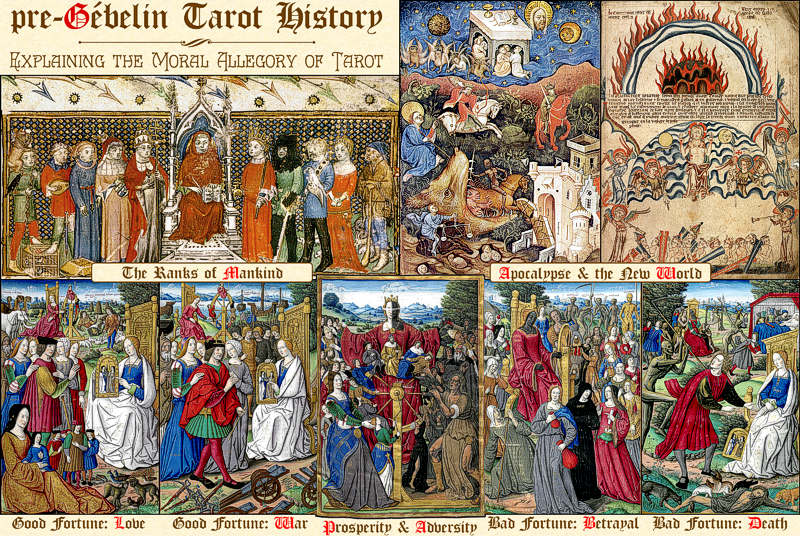"Italy is the source. Italy gave the world the game of Tarot; from Italy also derive the standard patterns used elsewhere for Italian-suited Tarots." (Michael Dummett)
Thierry Depaulis reports that the Calvinist theologian and ardent defender of witch-hunts, Lambert Daneau, (Professor of Theology at Geneva and the chair of Theology at Leyden), writing in a 1566 anti-gambling pamphlet titled Contre les jeux et joueurs, was the first writer to suggest that Tarot was the earliest form of playing cards. More than two centuries later, Antoine Court de Gébelin announced that Tarot's origins went back thousands of years to ancient Egypt. However, much better assessments regarding the origin of playing cards, and Tarot cards, were also presented in the 18th and 19th centuries.
Claude François Menestrier wrote Bibliotheque Curieuse (1704), which included a history of playing cards. Although seriously flawed by modern standards, this first attempt at basing a systematic history of playing cards on documentary evidence yielded an origin for cards in Europe that was off by about two decades from that indicated by current studies. Most subsequent writers also got the correct answer, at least to the nearest century, but it wasn't until 1980 that the available evidence was collected, evaluated, collated, analyzed, and used as the basis for a comfortably reliable history of the earliest playing cards in Europe and the invention of Tarot more than a half century later.
When it appeared in 1980 The Game of Tarot was acclaimed as a major contribution to the cultural history of mind games. This thick book -- over 600 pages -- drastically changed our views on this very special card game and on its no less special cards. With a wealth of impressive documentation Dummett arrived at several conclusions which pulled down old ideas. He first showed that the Tarot was not the "earliest form of playing cards" but that it was, on the contrary, a derivation of the earlier 52-card pack for which evidence exists as early as 1377.
Starting from a minute classification of the different types of Italian tarots, based on the order of these particular cards called trumps (Italian trionfi), Michael Dummett built up a threefold distribution among three main traditions of the Tarot which all rose in Northern Italy. To these three streams the author assigned three birthplaces: Milan, Ferrara, and Bologna. The earliest known packs being illuminated Tarot cards painted for the Visconti and Visconti-Sforza families who reigned in Milan, there is some probability that the Tarot was invented there in the first half of the fifteenth century; however, the Este court of Ferrara cannot be dismissed since the earliest record that bears evidence for the game of Tarot -- as "carte da trionfi" is to be found in the Ferrareese account-books of 1442. (Thierry Depaulis, in The Philosophy of Michael Dummett, 2007)
It is not the standard patterns that are historically of most importance, however, but the order of the trump sequence. One important feature is whether the highest trump is the Angle or the World. [...] There is a second important variation in the trump sequence: the position of the three Virtues. These differences in the trump sequence are the key to the history of Tarot in Italy. Clearly the determination of the order of the trumps must have occurred at the very beginning of the game in the earliest centres, since it is essential for play that all agree on their order. We can therefore identify three original centres of the game: Bologna, Ferrara and Milan. [...] The trump order observed in other locations shows from where the game had been derived. (Michael Dummett, "A Brief Sketch of the History of Tarot Cards", The Sylvia Mann Lecture, 2004, reproduced in The Playing-card, April-June 2005.)
The central fact around which the many specific details and the logic of the analyses revolve is that the origin of Tarot is not "lost in the mists of time" nor in any significant sense unknown. As illustrated dramatically in the above chart of the earliest evidence, Tarot was created around 1440 in Northern Italy. Its popularity spread very quickly. The red areas on the map indicate areas where evidence of Tarot is known from the first few decades after its invention.
______________________
Note: The table and map were originally adapted from Ross Caldwell, "Giovanni del Ponte and the dating of the Rothschild cards", The Playing-card, July-Sept 2007. The chart was updated 5/9/10, based on a new version Ross posted to the Tarot History Forum. The chart was updated again, 4/24/2012, based on a new version Ross posted, and the map was changed.




